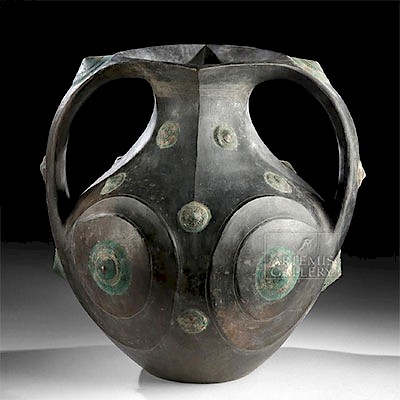Superb Chontal Greenstone Mask - Collected Before 1935
Lot 124a
About Seller
Artemis Fine Arts
686 S Taylor Ave, Ste 106
Louisville, CO 80027
United States
Selling antiquities, ancient and ethnographic art online since 1993, Artemis Gallery specializes in Classical Antiquities (Egyptian, Greek, Roman, Near Eastern), Asian, Pre-Columbian, African / Tribal / Oceanographic art. Our extensive inventory includes pottery, stone, metal, wood, glass and textil...Read more
Estimate:
$5,000 - $7,000
Absentee vs Live bid
Two ways to bid:
- Leave a max absentee bid and the platform will bid on your behalf up to your maximum bid during the live auction.
- Bid live during the auction and your bids will be submitted real-time to the auctioneer.
Bid Increments
| Price | Bid Increment |
|---|---|
| $0 | $25 |
| $300 | $50 |
| $1,000 | $100 |
| $2,000 | $250 |
| $5,000 | $500 |
| $10,000 | $1,000 |
| $20,000 | $2,500 |
| $50,000 | $5,000 |
| $100,000 | $10,000 |
| $200,000 | $20,000 |
About Auction
By Artemis Fine Arts
Jul 11, 2019
Set Reminder
2019-07-11 10:00:00
2019-07-11 10:00:00
America/New_York
Bidsquare
Bidsquare : Ancient / Ethnographic / Americana
https://www.bidsquare.com/auctions/artemis-gallery/ancient-ethnographic-americana-4246
Discover ancient art from Egypt, Greece, Italy, and the Near East, as well as Asian, Pre-Columbian, Tribal, Fossils and Fine Art. Also featuring a wonderful collection from a prominent New York estate whose owners reside in the Van Wyck family's historic Lloyd Harbor waterfront home. Artemis Fine Arts info@artemisfinearts.com
Discover ancient art from Egypt, Greece, Italy, and the Near East, as well as Asian, Pre-Columbian, Tribal, Fossils and Fine Art. Also featuring a wonderful collection from a prominent New York estate whose owners reside in the Van Wyck family's historic Lloyd Harbor waterfront home. Artemis Fine Arts info@artemisfinearts.com
- Lot Description
Pre-Columbian, Central Mexico, Guerrero region, Chontal, Late Preclassic period, ca. 300 to 100 BCE. A beautiful face mask of an oblong rectangular form, hand-carved from a mottled green stone with white and beige inclusions. The minimalist visage is defined by prototypical puffy cheeks and lips, deeply-pierced eyes, flush cheeks and chin, raised eyebrows connected to a large nose, and a heavy brow line. Each corner of the mask bears a biconically-drilled suspension hole, allowing it to be fastened to the face of a deceased individual. Custom museum-quality display stand included. Size: 5.125" W x 5.125" H (13 cm x 13 cm); 6.625" H (16.8 cm) on included custom stand.
The Guerrero region of modern-day southwestern Mexico was the center of the Mezcala and Chontal stone carving traditions. While Mezcala artists are known for their abstract, geometric style, the Chontal sculptors imbued their artworks with more naturalism. Although their stonework stems from the Preclassic period, ca. 300 to 100 BCE, later Mesoamerican peoples clearly cherished Chontal portable sculptures as heirlooms. Chontal creations have been unearthed in ritual caches at Templo Mayor, the principle temple of the 15th century Aztecs of Tenochtitlan (Mexico City).
What's more, legendary 20th century modernists such as Diego Rivera, Frida Kahlo, and Miguel Covarrubias appreciated the minimalist qualities of Chontal art. Covarrubias went so far as to compare it to the Cycladic style of ancient Greece. Scholars believe that such masks as this example were tied to funerary bundles of the noble elite; however, smaller scale masks suggest they may have been attached to clothing.
A slightly-larger and stylistically-similar example hammered for $31,070 at Christie's, New York "Important Pre-Columbian Art: A European Private Collection" Auction (sale 1537, November 12, 2004, lot 26): https://www.christies.com/lotfinder/Lot/a-chontal-stone-mask-late-preclassic-ca-4384403-details.aspx
Provenance: ex-private Arizona, USA collection; ex-Anastolio Estrada Morales collection, acquired in 1939, brought to the United States in 1942, by descent to his son, Rogaciano Ramirez
All items legal to buy/sell under U.S. Statute covering cultural patrimony Code 2600, CHAPTER 14, and are guaranteed to be as described or your money back.
A Certificate of Authenticity will accompany all winning bids.
We ship worldwide and handle all shipping in-house for your convenience.
#138080Surface wear and abrasions commensurate with age, some minor nicks around face and peripheries, and light roughness in some areas, otherwise intact and excellent. Nice earthen deposits throughout.Condition
- Shipping Info
-
All shipping is handled in-house for your convenience. Your invoice from Artemis Gallery will include shipping calculation instructions. If in doubt, please inquire BEFORE bidding for estimated shipping costs for individual items.
-
- Buyer's Premium



 EUR
EUR CAD
CAD AUD
AUD GBP
GBP MXN
MXN HKD
HKD CNY
CNY MYR
MYR SEK
SEK SGD
SGD CHF
CHF THB
THB














